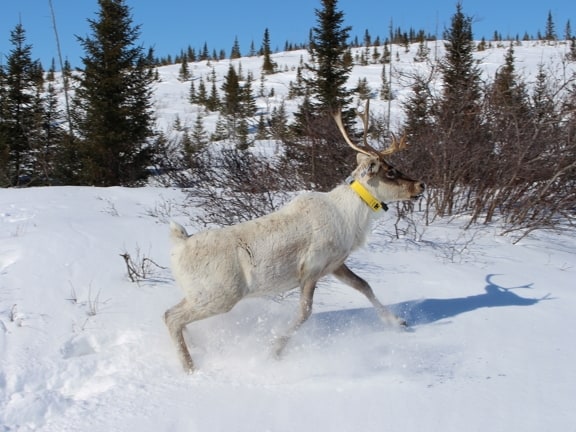

A team of researchers has fitted mother caribou in Canada’s North with “baby monitor” cameras to help scientists figure out why the Leaf River caribou population in Nunavik, Quebec, are dying off.
“The risk was that we might not see the calves on the camera. That’s what my colleagues were telling me,” said Steve Côté of the Department of Biology at the University of Laval and member of the Caribou Ungava research team, to NunatsiaqOnline. “But I proved them wrong. It worked really fine and it gives extra data as well.”
The Leaf River herd of boreal woodland caribou once numbered over 600,000 less than twenty years ago, but like other caribou populations in Canada’s North it has been hit with steep declines in recent years. A census taken last summer put the group at 181,000, a new low and down from 430,000 as recently as 2011.
The general consensus is that climate change along with human development are both major factors in the herd’s decline. Warmer winters disturbs caribou migration as travel across thinning sea ice becomes more treacherous and thawing-and-refreezing events are occurring more often and earlier, blocking the caribou’s access to ground lichen and other plants. As well, further industrialization in the North is causing disruptions to migration and calving grounds, said to be very sensitive to disturbances, leading to failed reproduction and calf abandonment.
Much is still unknown about caribou calving and exactly why reproduction isn’t occurring at the rate it should be. But scientists are in a bit of a bind, as investigating the causes comes with the risk of further disrupting herd conditions — hence the inspiration for the baby cams.
“We are very concerned with that and we would not want to do something that would disturb the animals because if we change their survival, if we change their behaviour, then we are not measuring what we should be measuring,” Côté said.
In March 2016, researchers outfitted 14 females with camera collars set up to take 10-second video clips every 20 minutes, 18 hours a day for 92 days. Relatively lightweight at 1.2 kg, the collars were programmed to drop off and, fit with GPS tracking, were then picked up for study.
The footage showed that 13 of the 14 females had calves and eight of these could still be seen in video evidence by the end of monitoring period. The video is remarkable, showing the caribou in all sorts of intimate and interactive settings.
Earlier this year, the Quebec government announced it was cutting in half the annual sport hunting allotment of Leaf River caribou, with 1,366 permits to be made available for 2017-18 and a promise that this will be the last year for the hunt.
Cree, Inuit and Naskapi representatives have called for an immediate halt to sport hunting, however. “In order for the herd to be sustainable and for it to be able to not decline, we have vocalized with the ministry that the sport hunt has to closed now,” said Adamie Delisle Alaku of Nunavik’s Makivik Corporation to CBC News. “With the sports hunting and the native harvest, we are already harvesting unsustainably. And that’s what we’ve been advocating to the ministry… and they have not been listening”
David Miller, CEO of WWF-Canada has called the decline of barren ground caribou “one of the greatest wildlife conservation concerns in Canada.”
Leave a Reply
You must be logged in to post a comment.




 Share
Share Tweet
Tweet Share
Share




Comment